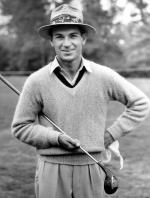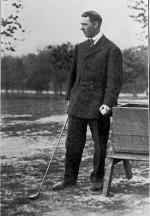![header=[Marker Text] body=[Oldest golf course in continuous use in the U.S. In 1887, land was made available to the newly formed Foxburg Golf Club by Joseph M. Fox, its first president. Course was enlarged from five to nine holes in 1888. The Foxburg Country Club purchased, in 1924, the original land which it had been leasing. ] sign](http://explorepahistory.com/kora/files/1/10/1-A-30B-139-ExplorePAHistory-a0k6c4-a_450.jpg)
Mouse over for marker text
Name:
Foxburg Golf Course
Region:
Allegheny National Forest Region
County:
Clarion
Marker Location:
PA 58 at NE end of Foxburg
Dedication Date:
June 1955
Behind the Marker
While Virginia boasts the nation's oldest tee box continuous in use, and Rhode Island the oldest green, Pennsylvania claims title to the golfing ground that's remained in play longer than any other. First laid out in 1887, Foxburg Golf Course (now the Foxburg Country Club) began as so many of the America's earliest romances with the game did: in a roundabout route from Scotland.
Joseph Fox was a young Philadelphia lawyer who had fallen for the English game of cricket while a student at Haverford College. In 1884, he was part of a team from Merion Cricket Club in Philadelphia that crossed the Atlantic to play a series of matches in the British Isles. While in Scotland, he took a whack at golf. Intrigued by the game, he brought back a set of clubs and balls so he could keep playing.
But where? There wasn't a golf course in Philadelphia then. Nor was there one in Pennsylvania, or for that matter anywhere else in the United States. Fox fixed that. He created a course of his own on the family estate, known as The Mansion, in the foothills of the Alleghenies sixty miles northeast of Pittsburgh, then sent away for more clubs and balls so his friends could join in the fun. In 1887, he relocated his playing field farther from the family home to a pasture on an escarpment above the Clarion and Allegheny rivers. As president, he formally organized the new location as The Foxburg Golf Club. The course, which Fox later gave to the community, was rudimentary at best, with just five holes–a set of flower pots in the ground, really. He expanded it to nine holes, as it remains today, in 1888, and while the course has been modified, remodeled, and upgraded over time, its address has never changed.
That simple course would lay the foundation to Pennsylvania's position as both keystone and cornerstone to golf in America. Over the next two decades the game, with its strict rules and stricter etiquette, became a favored pastime of the moneyed class, particularly among the Philadelphia upper crust and the steel barons of Pittsburgh. Soon, Philadelphia's Main Line was as connected by its new golf and country clubs as it had previously been by its railroad stations. Across the state, it was on a golf course in 1901 that Charles Schwab first approached his boss
Charles Schwab first approached his boss Andrew Carnegie about Carnegie's willingness to sell his eponymous steel company; the next day, Carnegie and his lawyers began drawing up the transfer papers that gave would birth to U.S. Steel.
Andrew Carnegie about Carnegie's willingness to sell his eponymous steel company; the next day, Carnegie and his lawyers began drawing up the transfer papers that gave would birth to U.S. Steel.
By 1910, Pennsylvania had already hosted a pair of U.S. Open championships, and the Opens come back often. Today, only New York has held more. In 2007, Oakmont Country Club, just outside Pittsburgh, became the first club to host the Open eight times. Beyond that, an assortment of other prestigious national championships–Women's Opens, Senior Opens, Amateurs, and PGAs–have been held on Pennsylvania's golf courses. So was the 1975 Ryder Cup. The American team that year was captained by a Pennsylvanian whose charismatic personality and go-for-broke style of play did more to popularize the game and excite the masses than anyone between Bobby Jones and Tiger Woods: Arnold Palmer.
Palmer learned the game from the ground up; his father was the superintendent and then head pro at Latrobe Country Club, not far from Pittsburgh. For men like Palmer, and countless other boys who grew up caddying, golf presented an opportunity. For men, in general, golf presented opportunities–to compete, to exercise, to socialize, to do business. For women, the story's not quite the same; for too long, clubs actively restricted their membership and gave men more favorable tee times. Still, women have played the game in Pennsylvania from the beginning, and one, Sewickly's Carole Semple Thompson, continues to tee it up as one of American golf's most successful and honored amateurs.
Two of golf's most thrilling moments are preserved in plaques on the storied East Course at Merion Golf Club, an offshoot of the old Cricket Club that Fox played for. In 1930, Bobby Jones arrived in Philadelphia needing a win in the U.S. Amateur to achieve something no one has ever done before or since: hold all four of the game's major titles in the same year. Jones dominated the competition at Merion, winning the title, and the Holy Grail of the Grand Slam, with ease.
Exactly twenty years later, Ben Hogan, still recovering from the automobile accident that crushed his legs and nearly killed him, hit what would become one of the game's most fabled shots: an improbable 1-iron on the 72nd hole of the U.S. Open. The shot, captured in one of golf's most reproduced photos, helped him come back to tie for the lead and force a play-off. Fighting through great physical pain, Hogan returned the next day to out-duel two players for the championship.
One of Hogan's foes that day was a Pennsylvanian named George Fazio who went on to a prolific career as a golf course designer. Earlier in the twentieth century, so many good designers–Hugh Wilson, A.W. Tillinghast, George Crump, William Flynn and George Thomas–came out of Philadelphia almost simultaneously that they became collectively known as the Philadelphia School. Their courses include Winged Foot, Baltusrol, Riviera, Shinnecock, Cherry Hills, Pine Valley, Newport, Bethpage, and Merion, all ranked among the nation's best.
Though now shorter than most championship courses, Merion is still revered for its strategic design and the daunting challenges it presents golfers of every caliber. Indeed, after an absence of more than thirty years, the Open is scheduled to be played there for the fifth time in 2013.
Joseph Fox was a young Philadelphia lawyer who had fallen for the English game of cricket while a student at Haverford College. In 1884, he was part of a team from Merion Cricket Club in Philadelphia that crossed the Atlantic to play a series of matches in the British Isles. While in Scotland, he took a whack at golf. Intrigued by the game, he brought back a set of clubs and balls so he could keep playing.
But where? There wasn't a golf course in Philadelphia then. Nor was there one in Pennsylvania, or for that matter anywhere else in the United States. Fox fixed that. He created a course of his own on the family estate, known as The Mansion, in the foothills of the Alleghenies sixty miles northeast of Pittsburgh, then sent away for more clubs and balls so his friends could join in the fun. In 1887, he relocated his playing field farther from the family home to a pasture on an escarpment above the Clarion and Allegheny rivers. As president, he formally organized the new location as The Foxburg Golf Club. The course, which Fox later gave to the community, was rudimentary at best, with just five holes–a set of flower pots in the ground, really. He expanded it to nine holes, as it remains today, in 1888, and while the course has been modified, remodeled, and upgraded over time, its address has never changed.
That simple course would lay the foundation to Pennsylvania's position as both keystone and cornerstone to golf in America. Over the next two decades the game, with its strict rules and stricter etiquette, became a favored pastime of the moneyed class, particularly among the Philadelphia upper crust and the steel barons of Pittsburgh. Soon, Philadelphia's Main Line was as connected by its new golf and country clubs as it had previously been by its railroad stations. Across the state, it was on a golf course in 1901 that
By 1910, Pennsylvania had already hosted a pair of U.S. Open championships, and the Opens come back often. Today, only New York has held more. In 2007, Oakmont Country Club, just outside Pittsburgh, became the first club to host the Open eight times. Beyond that, an assortment of other prestigious national championships–Women's Opens, Senior Opens, Amateurs, and PGAs–have been held on Pennsylvania's golf courses. So was the 1975 Ryder Cup. The American team that year was captained by a Pennsylvanian whose charismatic personality and go-for-broke style of play did more to popularize the game and excite the masses than anyone between Bobby Jones and Tiger Woods: Arnold Palmer.
Palmer learned the game from the ground up; his father was the superintendent and then head pro at Latrobe Country Club, not far from Pittsburgh. For men like Palmer, and countless other boys who grew up caddying, golf presented an opportunity. For men, in general, golf presented opportunities–to compete, to exercise, to socialize, to do business. For women, the story's not quite the same; for too long, clubs actively restricted their membership and gave men more favorable tee times. Still, women have played the game in Pennsylvania from the beginning, and one, Sewickly's Carole Semple Thompson, continues to tee it up as one of American golf's most successful and honored amateurs.
Two of golf's most thrilling moments are preserved in plaques on the storied East Course at Merion Golf Club, an offshoot of the old Cricket Club that Fox played for. In 1930, Bobby Jones arrived in Philadelphia needing a win in the U.S. Amateur to achieve something no one has ever done before or since: hold all four of the game's major titles in the same year. Jones dominated the competition at Merion, winning the title, and the Holy Grail of the Grand Slam, with ease.
Exactly twenty years later, Ben Hogan, still recovering from the automobile accident that crushed his legs and nearly killed him, hit what would become one of the game's most fabled shots: an improbable 1-iron on the 72nd hole of the U.S. Open. The shot, captured in one of golf's most reproduced photos, helped him come back to tie for the lead and force a play-off. Fighting through great physical pain, Hogan returned the next day to out-duel two players for the championship.
One of Hogan's foes that day was a Pennsylvanian named George Fazio who went on to a prolific career as a golf course designer. Earlier in the twentieth century, so many good designers–Hugh Wilson, A.W. Tillinghast, George Crump, William Flynn and George Thomas–came out of Philadelphia almost simultaneously that they became collectively known as the Philadelphia School. Their courses include Winged Foot, Baltusrol, Riviera, Shinnecock, Cherry Hills, Pine Valley, Newport, Bethpage, and Merion, all ranked among the nation's best.
Though now shorter than most championship courses, Merion is still revered for its strategic design and the daunting challenges it presents golfers of every caliber. Indeed, after an absence of more than thirty years, the Open is scheduled to be played there for the fifth time in 2013.









